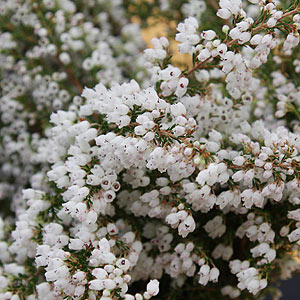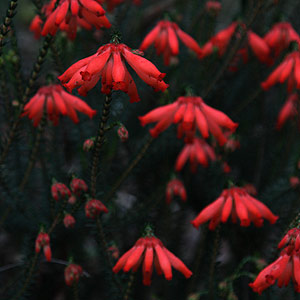
When gardeners mention heathers the thought immediately turns to Scotland, where in August to September they flower in abundance. These are the Calluna vulgarise, and although its only one species a great deal of variation exists.
Often heaths, which are related to heathers are lumped together with them, they are however a separate and more varied species, the Ericas. If you happen to be going to Scotland the best time for seeing the heathers is in August to September.
The difference between Heaths and Heathers.

The difference between heaths and heathers, besides the species, is that the Heathers (Calluna) are more cold hardy, and here in the USA they are capable of surviving to USDA zone 3, although 5 – 7 is a more comfortable range. The heaths (Erica species and cultivars) are best in warmer zones, generally USDA zones 7 – 9.
Another difference is that he foliage of heaths is a needle like form. Heathers are well known as natives of Scotland, they have a flat, scale-like foliage.
Hardy evergreen plants that add color to the garden year round, both Heaths and Heathers are a valuable addition to the garden. Many make great ground cover plants
They are generally a fairly tough and cold tolerant plants, they make great ground cover plants, and the foliage has fantastic colours.
- Calluna vulgaris is the sole species in the genus, they are known as the Heathers. They have scale like foliage they flower mainly in summer, through to fall.
- Heaths are from the Erica genus with over 500 species. These have needle like foliage and flower from winter to summer depending on variety.
Care of Heaths and Heathers
- All Heaths and Heathers are low growing, evergreen and generally tough plants.
- Both Heaths and Heathers require a minimum of 6 hours light a day to promote adequate flowering.
- Soil conditions are not so important, both do well in poor soils, slightly alkaline soils seems best, mulch well after planting.
- They require little to no fertilizer.
- Mulch to provide a cool root run.
- Both Heaths and Heathers can be regarded as reasonably drought resistant once established.
- Calluna (Heathers) can be pruned back to below spent flowers. Erica (Heath’s) should be tip pruned to maintain shape.
Heathers
All varieties are wind and cold tolerant, they require little water one established. Soil type is similar to that of Rhododendrons and Azaleas. Nearly all varieties prefer full sun, although some of the golden foliage cultivars will take a little shade.
Heaths
Good drainage is essential, a slightly acidic soil with perhaps a little shade during the afternoon. Do not use lime, and do not use manures as Ericas do nor seem to to like either.
In colder zones some protection in winter by giving a light covering of leaves can be beneficial.
Pruning Heathers
As Calluna vulgaris are a summer flowering plant they are best pruned after flowering in late summer to fall. Alway prune back into the newer green wood, not the old wood, very hard pruning can kill the plants.
Pruning Heaths
This will depend on the species, some are summer flowering, some are winter flowering, so keep note of which variety you have in the garden. If in doubt prune lightly after flowering.
Varieties
Calluna
- Flamingo,
- Kerstin,
- Martha Herman,
- Roland Haagen
Erica
Pictured right we have Erica canaliculata (syn E.melanthera) a white flowering heath, also known as the ‘Channelled Heath’. Erica cerinthoides also known as the ‘Hairy Heath’ is another spectacular species.
One of the easiest hybrids to grow is Erica x darlyensis, good white flowers in spring, perhaps not as fussy about soil types and its been around since the late 1800s.
- King George,
- Springwood Pink,
- C. D. Eason,
- Furzey
- Kramer’s Red,
- W. T. Rackliff
- Erica cerinthoides
Generally Calluna varieties will flower from June to October, with Highland Rose and Red Pimpernel two of the earliest with Peter Sparkes and Iris Van Leyen being two of the latest.
Height is another factor in choice, The low growing J.F Letts reaches only around 4 “ in height, the aptly names Pygmaea is even lower. Hammondii alba with white flowers will reach 24 “ as will Elsie Purnell with its crimson red flowers and Gold Haze, golden foliage with white flowers.
Tree Heaths
The so called ‘Tree Heaths’ ( Erica arborea and Erica lusitanica. ) can reach to 4ft, these are called Erica x ‘Veitchii, with its white flowers is one, ‘Australis’ with Rosey Red flowers will reach around 3 ft.
Landscaping Uses
As these are a non invasive, drought tolerant, low maintenance , low fertilizer plant, uses in the garden are many.
Use them in mass planting in the broader landscape. Grow them in the rock garden, or try them as fillers in the perennial border where the year round color is a welcome relief to seasonal perennials.
Heaths and Heathers are available for sale form the following Nurseries
DIGGING DOG NURSERY – phone (707) 937-1130
PO Box 471 Albion CA 95410

